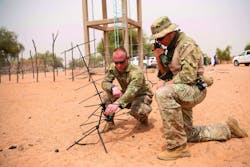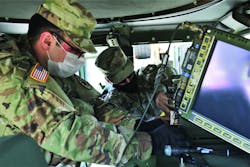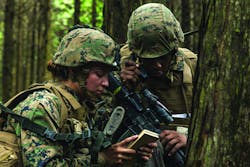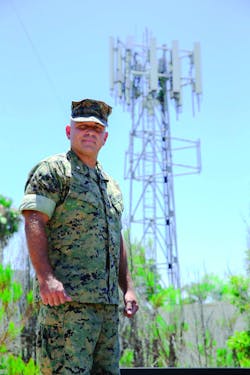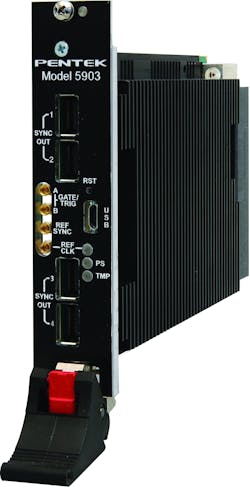NASHUA, N.H. - Emerging fifth-generation wireless communications — better-known as 5G — will be far more than quick-connect phone calls and fast movie downloads, particularly for the U.S. military. 5G, in fact, could make reality of what military leaders as far back as the 1980s referred to as the “infosphere,” where access to data from video, voice, sensors, targeting, reconnaissance, and even the sights on infantry weapons are easy and instantaneous for anyone who needs it.
5G holds the promise of ubiquitous high-speed data connectivity: vastly improved intelligence, surveillance, and reconnaissance (ISR); fast and secure command and control; more efficient logistics; swarming unmanned vehicles; and wide use of virtual reality and augmented reality for simulation, training, and mission rehearsal. The promise of 5G is for instant situational awareness anywhere on Earth, smart hypersonic weapons with re-targeting on-the-fly, rich access to mission-critical data on the leading edge of the battlefield, and unmanned aircraft that can fly safely alongside passenger aircraft in commercial airspace.
5G, however, will not come easily, quickly, or inexpensively. When compared to the overall 5G vision for the military, commercial interests, and for the consumer, the technology today is only in its infancy — despite the advertising we see on TV from cell phone providers. Bringing the 5G future to fruition will require time, much testing, experimentation, investment — and a whole lot more cell towers than we have today.
What is 5G?
5G is to increase the speed, reduce the latency, and improve reliability of data transfer compared to existing 4G technologies, and support interconnected orFor the military, 5G could improve ISR systems and signal processing, enable new command-and-control applications, and streamline logistics. 5G also could give the military broad access to augmented and virtual reality, 5G smart warehousing, distributed command and control, and dynamic spectrum use.
To do all this, 5G will operate on three segments of the electromagnetic spectrum:
low band, which operates at frequencies lower than 1 GHz;
mid band, which operates at frequencies between 1 GHz and 6 GHz; and
high band, or millimeter wave, which operates at frequencies between 24 and 300 GHz.
Low band and mid band collectively also are called sub-6, and this is where all of today’s so-called 5G cell phone services operate. Although sub-6 frequencies can offer faster service than cellular 3G and 4G, the sub-6 frequencies offer capabilities that will lag far behind most future high-band systems.
High bands’s use of millimeter waves will enable faster data transfer rates, which some telecommunications companies argue is necessary for autonomous vehicles, virtual reality, and other data-intensive applications like smart cities, according to the Congressional Research Service report.
Yet there are substantial technology tradeoffs when moving to the high band’s millimeter waves. RF signals in the 24-to-300-GHz bands can be absorbed by rain“Unlike 3G, the 5G technologies represent more than a radio capability,” says Ian Dunn, vice president of advanced development and chief scientist at embedded computing and electronic warfare (EW) specialist Mercury Systems in Andover, Mass. “It is a mobile infrastructure as a service, mobile computing as a service, and can be tailored and provisioned for each user.”
The military faces even stronger technological challenges because of the need to deploy 5G capabilities on the leading edge of the battlefield, where little, if any, 5G infrastructure exists, and where intentional RF jamming or other kinds of interference from enemies is likely.
High-band signals “have a lot of different characteristics than sub-6,” explains Rodger Hosking, vice president of embedded computing and signals intelligence expert Pentek Inc. in Upper Saddle River, N.J. “Those signals don’t travel very far and are very easily absorbed. You would need more cell towers and smaller cells. the advantage is you get these tremendous data rates and capabilities. The high band is much faster and can carry more information on those signals.”
5G military capabilities
The U.S. Department of Defense (DOD) 5G Strategy report, published last May, says 5G has the potential to transform military capabilities. “Ubiquitous high-speed connectivity will also transform the way militaries operate,” according to the report. “Tomorrow’s warfighters will use local and expeditionary 5G networks to move massive amounts of data to connect distant sensors and weapons into a dense, resilient battlefield network.
Persistent Systems in New York City specializes in mobile ad-hoc networking (MANET) technology for a variety of applications such as controlling groups of unmanned vehicles in difficult terrain. Persistent has expertise in real-time switching between different RF frequencies to find the most reliable pathways in a given set of conditions. Company engineers make use of satellite communications (SATCOM) channels, land mobile radio, and RF repeaters mounted on unmanned aircraft and even on other handheld radios to sample the RF environment constantly and adapt in real time to changing conditions.
As such, the company will not be an exclusive user of 5G networking, but instead will use 5G as the technology matures to enhance the reliability of ad-hoc networks.
“We are excited about the opportunity to network with another technology beyond military tactical radio, which is old and somewhat limited,” explains Adrien Robenhymer, Persistent’s vice president of business development for Air Force and intelligence community applications. “5G offers the military another network pathway.”
Adding 5G as another communications layer also offers to enhance the reliability of military networks — particularly when they operate in contested environments. “In the DOD space, being able to transition between networks is very critical,” Robenhymer says, explaining that Persistent Systems experts have demonstrated the ability to use 5G and 4G wireless technologies together with the company’s MANET technology, with the addition of SATCOM systems.
“From virtual reality, to robots, to the simple logistics of flight-line operations, to counter-unmanned systems where threats are flying into military bases. Having some additional communications layers to leverage widens the aperture.”
The speed of data
The speed of data throughput is among the biggest enablers that 5G offers. “You are going from kilobits to megabits, but with 5G you see hundreds of megabits,”Backward-compatibility of 5G with its 4G and 3G predecessors also will be an important consideration for systems designers — particularly in MANET-like architectures that hop to different bands based on spectrum availability.
“Our customers are seeing the base stations for 5G that will operate at significantly higher speed,” says Mike Southworth, senior product manager at the Curtiss-Wright Corp. Defense Solutions division in Salt Lake City. “4G and 3G devices are there today, so 5G base stations should be able also to support 4G and 3G.”
Southworth says he envisions many new military applications that 5G throughput could provide. “Warfighters in an aircraft could use augmented-reality goggles to control drones launched off the aircraft; you are gaming, yet with an actual drone.”
Enabling unmanned aerial vehicles (UAVs) to operate safely in congested commercial air space with commercial passenger aircraft, business jets, and commercial helicopters also lends itself to 5G, Southworth says. “Commercial drones operating in commercial air space — 5G was the infrastructure they were thinking of using for the drones to communicate. Not crashing into something else, and collision-avoidance, 5G could help enable that.”
Networking separate infantry warfighters also is a potential application of 5G, says Pentek’s Hosking. “The military increasingly relies on data-connected warfighters. That means connecting soldiers, vehicles, command posts, ships, satellites, and planes with information that consists of everything that you know, using voice, data, imagery, and signals-intelligence information. 5G gives the military the potential for boosting the data rate capabilities between the links of these operations by 20 to 100 times faster than the current state of the art of LTE or 4G wireless speeds.”
Couple 5G networking with artificial intelligence (AI) and machine learning, and potential new applications start to expand exponentially, Hosking points out.“Machine learning and AI are extremely important to the military because it will dictate how we conduct warfighting and go head-to-head with an enemy that has his own AI and machine learning,” Hosking says. “We could have unmanned vehicles and smart munitions that are attacking, evading, targeting, and re-targeting.”
Real-time command and control is another possibility, he says. The number of network-connected sensors on manned and unmanned platforms is likely to grow quickly once advanced 5G technologies sees broad deployment. “How do you put all that stuff together for actionable intelligence?” Hosking asks. “It is a hugely complex problem, and that’s where AI and machine learning come in. 5G is the connection, and its bandwidth will support these information channels. The AI and machine learning need a faster interface to sort all this out.”
Such high data throughput also could enable several uses of military systems that originally were designed for just one use. “Software-defined radio was focused on software-defined recongigurability,” says Mercury’s Dunn. “Now we’re talking about software-defined functionality. Think of how you could re-invigorate military platforms.”
High throughput also could enable new uses of tactical cloud computing as systems designers no longer have to worry about the latency of sending and receiving data from the cloud. “Cloud-native is the notion of taking an application built for the cloud and deploy it to the edge just as easily as it can be part of the core of the cloud,” Dunn says. “The application is defined in software and seamlessly moved to the edge.”
Drawbacks and tradeoffs
High-band 5G signals, which will operate in the millimeter wave range, hold the brightest potential for new military capabilities, but the ability to operate in these frequencies will come at a price — namely the need to build many more fixed-site and mobile antennas and towers than today’s 3G and 4G cell services require.
“5G frequency bands do not penetrate walls very well, or rain or foliage very well,” says Persistent Systems’s Robenhymer. “The way it is architected you need a lot of towers, or radiators, in your office or home. It adds to the complexity of 5G, but it is still a limiting factor in coverage and the number of towers you would need.”
The stationary nature of most of the cell tower infrastructure may necessitate sizable investments in building new 5G towers — especially for the military, which“Our customers are seeing the base stations for 5G that will operate at a significantly higher speed, but at shorter ranges,” says Curtiss-Wright’s Southworth. “The military will have to implement many more base stations to get the coverage they need.”
The military, especially, ultimately will need a new kind of mobile 5G infrastructure to ensure that the next-generation infosphere will be available wherever the military operates. “It’s a question of the reliance on these systems,” points out Persistent Systems’s Robenhymer. “That could be a problem unless we can cut the cord and really start moving these systems around.”
5G antennas must be complex designs. “All the 5G bands use multiple-element antennas,” says Pentek’s Hosking. “Each antenna is connected to its own transceiver; there are 64 elements — each of which is a small antenna itself, but arranged in a grid so they act in a phased array for beam steering.”
Designing the 5G antennas themselves in the small size and rugged packaging that the military needs also will be a challenge. “One of the key things in 5G is the ability to manage these antennas,” Hosking says. “You have to think about the dimensions of these 64-element antennas, because the space between the elements gets tighter as you go up in frequency. You could have an array in a fairly small area, but the electronics still must fit in that area. Getting the electronics of the transmit/receive antennas integrated into that space is a challenge.”
Moving to 5G also confronts the military with complicated new requirements for technology development and procurement. “If you adopt this 5G deployment paradigm, it necessitates a change in the software-engineering culture,” says Mercury’s Dunn. “If my users subscribe to resources throughout a network, like surveillance and characterization of new signals, then I need the software and engineering methodology to be different from ever before?
The need for these kinds of changes comes from the expected rapid tempo of technology development, upgrades, and technology insertion that 5G will provide to the military. “It’s a paradigm shift, that to achieve the subscription of new capabilities, you need new capabilities, and you need to speed up engineering to speed up the software engineering that you already have. Software development must be faster than it’s ever been before,” Dunn says.
Then comes the question of 5G spectrum, who controls it, and when. “Does the military 5G use the same spectrum as commercial 5G users, and if so, what happens in a crisis?” asks Persistent Systems’s Robenhymer. “Does the military take over commercial cellular telecommunications, or do they use a separate spectrum? That issue is a really big deal.”
Data security
5G communications must have data security built-in. “Because 5G networks will transport massive amounts of sensitive personal, corporate, and government information, they are particularly attractive targets for potential U.S. adversaries,” states the DOD 5G Strategy document. “With persistent access to an ally’s 5G network, an adversary could potentially engage in widespread espionage, threaten the privacy rights of citizens globally, prepare the operational environment to provide an advantage in armed conflict, conduct information operations, and/or protections. The U.S. government also encourages allies and partners to prioritize security considerations by avoiding untrusted and unreliable suppliers for their 5G networks, even as DOD seeks to be prepared to operate in all network environments.”
Pentek’s Hosking points out that the relatively short range of millimeter wave 5G signals provides some inherent security, much the same as the short range of some of today’s wireless signals helps keep users safe. “Take Bluetooth, which is a very small cell,” Hosking says. “No one farther away from about 30 feet can pick up that signal or interfere with it.”
Electronic eavesdropping, electronic warfare jamming, and inadvertent electronic interference from nearby transmitters all are threats to the reliability and integrity of 5G, and experts must deal with these issues sooner rather than later.
“The vulnerability of any cell system is if you jam it or cut power to any tower, then all the handsets in that footprint are useless,” points out Persistent Systems’s Robenhymer. In any 5G design, engineers must as the question, what are the vulnerabilities.
The DOD 5G Strategy document puts a priority on 5G security. “DOD must assess 5G vulnerabilities and develop security principles for equipment, architecture, and operations,” the document states. “In-depth protection also requires adoption of compliance standards for 5G design, cyber security for 5G infrastructure, and implementation of a ‘zero-trust’ security model.”
The notion of zero-trust requires all users — even those inside the organization’s enterprise network — to be authenticated, authorized, and continuously validated before getting access to applications and data. This approach capitalizes on advanced technologies like multifactor authentication, identity and access management, and next-generation endpoint security to verify the user’s identity and maintain system security.
5G enabling technologies
So what kinds of enabling technologies does it take to put reliable 5G networking in the military’s hands? Embedded computing companies are particularly wellCurtiss-Wright, for example, offers high-performance embedded computing components — which company officials refer to as building blocks — to help control and process data from 5G signals. “At Curtiss-Wright we consider ourselves a hardware provider, and not a solutions provider,” Southworth says. “We will provide building blocks that will become part of the 5G architecture.”
Curtiss-Wright specializes in small-form-factor rugged 3U VPX computer boards that are optimized for small size, weight, and power consumption that are suitable for military uses. “We are developing our first software-defined radio card,” Southworth says. “By nature of being software-defined, it means what frequency do you want to operate on? It could be a fundamental building block for 5G.”
Although embedded computer designers have technologies that could benefit 5G, this technology path is not a one-way street. The 5G vision also is helping direct embedded computing suppliers toward future products and applications.
“What wireless communications have brought to the DOD and the embedded community is a distributed architecture, which is different from the cloud,” explains Mercury’s Dunn. “Wireless is mobile, is on all the time, and its quality of service adjusts as you move around. It is a good example of a distributed communications infrastructure. We now have an infrastructure as a service in the mobility model. There is a real-time need for voice, data, and beyond, and 5G is just another increment of this model that likely will be useful to the C4ISR industry, where mobility is one of the most important aspects of the tactical edge.”
Radio technology for cell phone communications “is maturing very quickly, creating opportunities for the embedded world in general,” Dunn says. “We are now in another wave where those technologies are starting to push into defense, such as wideband radio communications.” RF cell phone technology, from analog RF, to field-programmable gate arrays FPGAs), to monolithic microwave integrated circuits (MMICs) “are chasing the opportunity to provide to defense,” Dunn says.
Advanced 5G technologies such as millimeter wave signals, still have much development work to become viable to military and commercial users, Dunn says, adding “We are incorporating some of these technologies into our products, and I expect another one to two years of maturity before we see widespread adoption.”
5G military programs
The U.S. Department of Defense has designated several military bases as 5G test beds to try out enabling technologies and to device new 5G military applications. Just last month DOD announced $600 million in contracts for 5G experimentation and testing at five military test sites, which represents the largest full-scale 5G tests for dual-use applications in the world.
Those five sites are Joint Base Lewis-McChord, Wash.; Naval Base San Diego, Calif.; Marine Corps Logistics Base Albany, Ga.; Nellis Air Force Base, Nev.; and Hill Air Force Base, Utah.
5G tests and experiments at Joint Base Lewis-McChord will sponsor testing of augmented reality and virtual reality training. Contractors involved at this site are GBL Systems Corp. in Camarillo, Calif.; AT&T Corp. in Bedminster, N.J.; Vectrus Mission Solutions Corp. in Alexandria, Va.; and Deloitte Consulting LLP in New York City.
These contractors will work with military experts to field a scalable, resilient, and secure 5G network to provide a test bed for 5G-enabled virtual reality and augmented reality for mission planning, distributed training, and operational use.
Experiments at Naval Base San Diego will involve 5G smart warehouse transshipment. Contractors are AT&T; GE Global Research in Niskayuna, N.Y.; Vectrus Mission Solutions; and Deloitte Consulting. These tests seek to develop a 5G-enabled smart warehouse that focuses on transshipment between shore facilities and naval units to increase the efficiency and fidelity of naval logistic operations like identification, recording, organization, storage, retrieval, and transportation of materiel and supplies.
Albany Marine Corps Base will focus on 5G vehicular smart warehousing. Contractors are Federated Wireless Inc. in Arlington, Va.; GE Research; KPMG LLP in Amstelveen, the Netherlands; and Scientific Research Corp. (SRC) in Atlanta. These tests will develop a 5G-enabled smart warehouse that focuses on vehicular storage and maintenance.
The Nellis Air Force Base tests involve distributed command and control. The primary contractor is AT&T, which will develop a testbed for applying 5G technologies to air, space, and cyberspace lethality, while enhancing command and control survivability. A 5G network will help disaggregate and mobilize existing command-and-control architectures in an agile combat employment scenario.
The Hill Air Force Base tests will involve dynamic spectrum utilization. Contractors are Nokia Corp. in Espoo, Finland; General Dynamics Mission Systems in Fairfax, Va.; Booz-Allen Hamilton in McLean, Va.; Key Bridge Wireless LLC in McLean, Va.; Shared Spectrum Co. (SSC) in Vienna, Va.; and Ericsson in Stockholm, Sweden.

John Keller | Editor-in-Chief
John Keller is the Editor-in-Chief, Military & Aerospace Electronics Magazine--provides extensive coverage and analysis of enabling electronics and optoelectronic technologies in military, space and commercial aviation applications. John has been a member of the Military & Aerospace Electronics staff since 1989 and chief editor since 1995.


